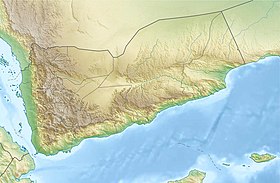al-Masajid
al-Masajid in what is now Yemen |
al-Masajid ( Old South Arabic Maʿrabum , Arabic المساجد, DMG al-Masāǧid ) is an archaeological place from the Old South Arabian - Sabaic epoch of the edge of the Yemen highlands basin below the ridge of the Dschabal Sahl is, in the border region to the former Qataban .
history
The ancient site goes back to the building activities of the Sabaean Mukarrib Yada'il Dharih I , whose reign of Hermann von Wissmann around 660 BC. BC, by Kenneth A. Kitchen, however, around 490-470 BC. Is set. He left the three most important of the Almaqah temples dedicated to the moon god , the Awwam temple at the gates of the capital Marib , the temple of Sirwah and that of al-Masajid. The latter bore the name of the Sabaean capital Ma'rib (not to be confused with the capital). In addition, Yada'il Dharih I established a fortification which is mentioned several times as Murad . Inscriptions (cited as RES 3949 and Gl 1108, 1109, 1122, 1116 and 1120), which Eduard Glaser had copied, testify to this . The French researcher for Semitic languages , Jacqueline Pirenne , was able to use local inscriptions to demonstrate how changes were made to the graphic representation of letters.
Temple complex
The elliptical temple complex is in a poor state of preservation, the temple itself is in the rubble. Only the remains of the foundation give an idea of its former glory. The Egyptian archaeologist Ahmed Fakhry , who first described the temple, was able to trace that it was built in the usual square design. Architecturally, it followed the basic principle of a rectangular, columned, uncovered courtyard, on one side of which was the cella ( mknt ). Sacrifices were made in the courtyard (cited as RES 2771 (line 6) and 2774 (line 3)). The entire complex was enclosed by a stone wall and housed a 100 × 37 meter Temenos , with three entrances at the front. The middle one was emphasized by a pillar propylon. The plan and plan reflect the prototype of the Sabaean temple building.
The one from the 8./7. The temple dating back to the 19th century was in cultic use for centuries, which is why circumstances demanded that it had to be renewed and changed in order to shine in a new light according to the prevailing taste of the time. Over time, his architecture showed ornamentation elements that indicate that they were added at a much later time, such as floral compositions and foreign style influences. In terms of furnishings, the temple is said to have contained metal, larger-than-life animal sculptures , as well as votive images and votive gifts in the form of inscription steles and those with other figurative representations.
see also article section: Architectural history of South Arabia
literature
- Horst Kopp (Ed.): Geography of Yemen . Dr. Ludwig Reichert Verlag Wiesbaden, 2005, ISBN 3-89500-500-2
- Walter W. Müller : Sketch of the history of old South Arabia . In: Werner Daum: Yemen , Umschau, Frankfurt / Main, ISBN 3-7016-2251-5 ; Pp. 50-56
- Jürgen Schmidt : Old South Arabian cult buildings . In: Werner Daum: Yemen , Umschau, Frankfurt / Main, ISBN 3-7016-2251-5 ; Pp. 81-101
- Hermann von Wissmann : On the history and regional studies of old South Arabia. ( Eduard Glaser Collection , No. III = Austrian Academy of Sciences, Philosophical-Historical Class, Meeting Reports, Volume 246) , Böhlaus, Vienna 1964.
- Hermann von Wissmann, Maria Höfner : Contributions to the historical geography of pre-Islamic South Arabia (= treatises of the humanities and social science class of the Academy of Sciences and Literature in Mainz , born 1952, No. 4). Publishing house of the Academy of Sciences and Literature in Mainz, Mainz 1953
Individual evidence
- ↑ a b Walter W. Müller , sketch of the history of Altsüdarabiens , (see lit.), pp. 50–53
- ↑ Horst Kopp (ed.): Yemen geography . Dr. Ludwig Reichert Verlag Wiesbaden, 2005, ISBN 3-89500-500-2 , pp. 30 and 37.
- ^ A b Hermann von Wissmann, Maria Höfner : Contributions to the historical geography of pre-Islamic South Arabia (= Academy of Sciences and Literature, Treatises of the Humanities and Social Sciences Class , 1952, No. 4). Franz Steiner, Wiesbaden 1971, pp. 22, 25, 30.
- ^ A b c Hermann von Wissmann , Collection Eduard Glaser III, On the history and regional studies of Old South Arabia, pp. 31–32; 262 and 210 (shown on the card)
- ↑ cited as CIH 957
- ↑ a b c d Jürgen Schmidt , Altsüdarabische Kultbauten, (see lit.), pp. 84–87; 98 f.
- ^ Maria Höfner, Südarabien in Dietz Otto Edzard, Götter und Mythen im Vorderen Orient ( Dictionary of Mythology ), p. 544 f. ( online )
